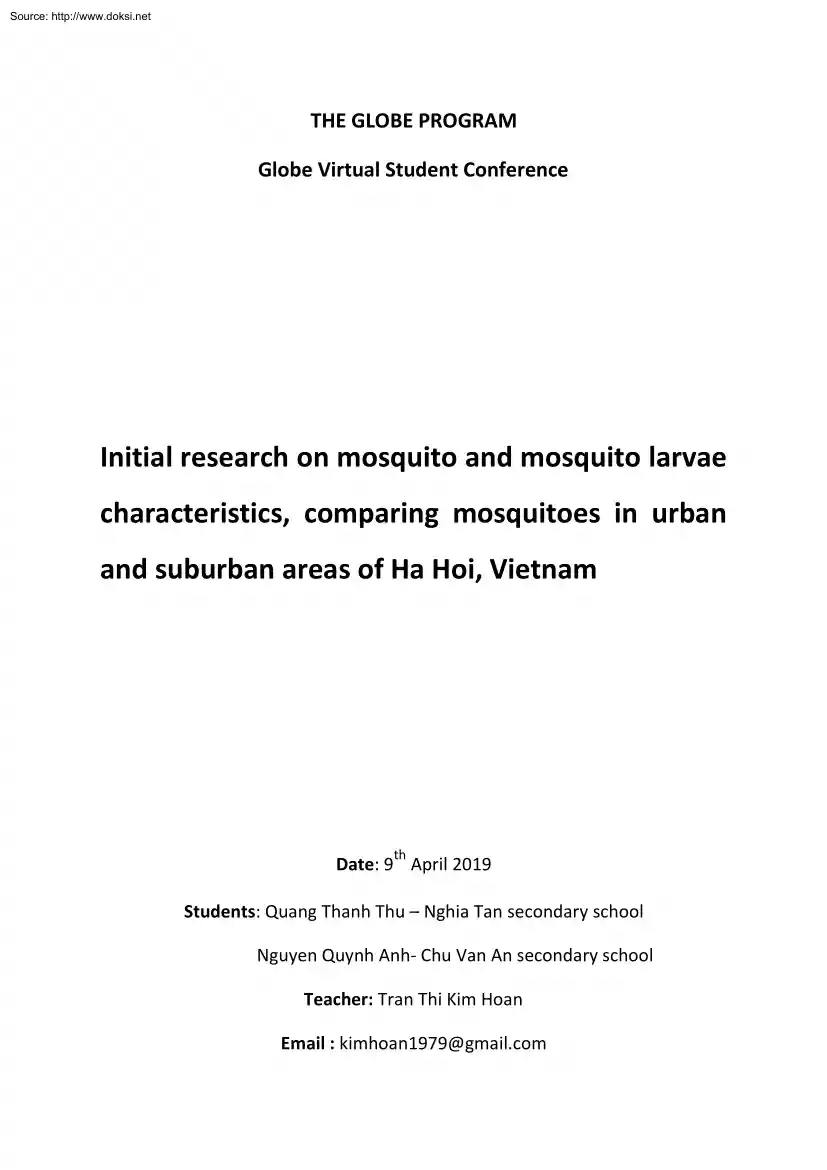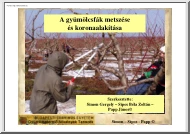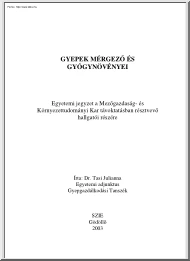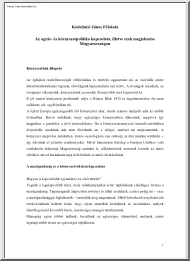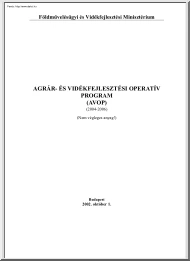Datasheet
Year, pagecount:2019, 13 page(s)
Language:English
Downloads:2
Uploaded:June 04, 2020
Size:778 KB
Institution:
-
Comments:
Nghia Tan secondary school
Attachment:-
Download in PDF:Please log in!
Comments
No comments yet. You can be the first!Content extract
Source: http://www.doksinet THE GLOBE PROGRAM Globe Virtual Student Conference Initial research on mosquito and mosquito larvae characteristics, comparing mosquitoes in urban and suburban areas of Ha Hoi, Vietnam th Date: 9 April 2019 Students: Quang Thanh Thu – Nghia Tan secondary school Nguyen Quynh Anh- Chu Van An secondary school Teacher: Tran Thi Kim Hoan Email : kimhoan1979@gmail.com Source: http://www.doksinet Table of contents Abstractpage 1 Introductionpage 2 Research question.page 3 Hypothesis.page 4 Analysis and Results.pages 9 and 10 Conclusions.page 10 Discussion.page 11 Referencespage 12 Bibliographypage 13 2 Source: http://www.doksinet Abstract Mosquitoes are familiar in Vietnam, like other tropical region. Mosquitoes often appear in March and April in Hanoi, Vietnam; mostly between spring and summer when there are high humidity condition. along with high population density, houses with small structure of houses, some people live under the first
floor so mosquitoes often fly in the house and mosquitoes appear as a daily habit of people, at night go to sleep, if not using mosquito nets, mosquitoes will buzz uncomfortable, and bite young children. Furthermore last year, in 2018, some classmates in our school have dengue fever in the classroom, making their tired of affecting the health and education and increasing the financial resources for families. With the aim of reducing the number of mosquitoes and larvae, leading to reducing dengue fever to families and communities, increasing awareness for the community about diseases, the research team chose the time of the study to be the beginning of the season to provide effective ways to prevent diseases, study mosquito larvae, identity characteristics of three types of mosquitoes including aedes, anophenles and culex, which are the cause of about 17% of the total cases global infection according to ROB Grenfell CISRO. By spreading out mosquito traps. The study provides a practical,
diverse approach to the location, sampling at places such as the school, sewages, and following the methods of sampling, collecting, statistics and consultation community. Thereby giving the results of mosquito place, recommended prevention of epidemics to different communities. 3 Source: http://www.doksinet INTRODUCTION Climate change has changed and moved the climate zones to the north, while affecting the distribution of temperature, rainfall and humidity in all regions of the world. These are factors that directly affect the reproduction and development of mosquitoes that transmit dengue fever, Aedes aegypti. There have been many studies predicting scope expansion and the number of dengue outbreaks will generally increase globally. Southeast Asia is also in the general trend that the level of dengue fever will be stronger and the frequency of outbreaks of epidemics is increasing. Vietnam is one of a country of Southest Asia In recent years, epidemics in Vietnam have complicated
developments, seriously affecting human health. Among them, there must be DEN epidemic, one of the increasing epidemics and complex developments in Vietnam. The transmission of DEN through the vector of transmission is the mosquito (Aedes aegypti and Aedes albopictus). With conditions above 200C and heavy rain are favorable conditions for disease vectors to develop. The recent monitoring results of the Hanoi Preventive Medicine Center show that the density of midges is 3 to 3.5 times higher than previous years, which is the cause of high epidemic rates, while There are no vaccines currently available. We chose Hanoi, with two places are suburban and inner cities of Hanoi in northern Vietnam. With the climate change situation in recent years, the number of DEN diseases is increasing in Hanoi. If the number of mosquitoes is reduced at the beginning of the season, the number of infected patients will be reduced, so we choose the study time at the beginning of the epidemic season, which is
the first 3 months of the year from January to March 2019. Within the first 3 months of 2019, the country recorded more than 47,000 cases of dengue, of which 2 cases died. Compared to the same period in 2018, the number of people suffering from dengue increased 3.7 times Particularly, Hanoi city recorded 154 cases of dengue fever, increased more than 2.2 times compared to the same period in 2018 The number of scattered patients in 99 communes, wards and towns of 27/30 districts , town, but no death cases -Additionally, people in the commune waste water into rivers, lakes, tanks, etc. Drainage ditches are congested because of garbage, widespread domestic 4 Source: http://www.doksinet garbage on the road, especially in the rainy season, causing localities to face the risk of outbreaks. In Vietnam, in the summer and the annual rainy season, increasing number of mosquitoes regularly causes diseases that cause many deaths, causing Hanoi epidemic: In 2016, there were 60,000 cases of
fevers blood. By the end of 2017 there were 163,600 cases of illness (30 deaths). In the first 3 months of 2018, there were 14,100 dengue cases (3 people died) and 26/63 provinces and cities in Vietnam had dengue fever, followed by ZIKA virus in 11 provinces and cities of Vietnam. Zika with over 200 cases Cau Giay climate is divided into 2 seasons, the hot season starts from April to October, the highest temperature is 380C, the rain is concentrated from. The average humidity is 84.5%The point of study of the inner city is Cau Giay district, located in the northern capital of Hanoi, where the DEN is mainly followed. According to the doctors in the Department of Tropical Diseases, patients examined and treated in Tropical Diseases are mainly 5 Source: http://www.doksinet concentrated in Mai Dich, Dich Vong, Cau Dien (Cau Giay district), Nam Tu Liem, Bac Tu Liem Pic 1: Cau Giay Urban, signal H: Nghia Tan secondary school Thanh Tri district consists of 1 town, Van Dien town and 15
communes: Dai Ang, Dong My, Duyen Ha, Huu Hoa, Lien Ninh, Ngoc Hoi, Ngu Hiep, Ta Thanh Oai, Tam Hiep, Tan Trieu, Thanh Liet, Tu Hiep, Van Phuc, Vinh Quynh, Yen My. Total of 198,706 people (2009) Density, 3,145 people / km. Climate same in Cau Giay district, the annual average temperature is about 230C with 85% humidity. Particularly concentrated in some communes, such as Tan Trieu, Ta Thanh Oai, Tu Hiep, Van Dien town . are the localities with high rate of people suffering from dengue fever and many outbreaks in 2017. In 10 months of 2018, in the whole district, there were only 87 cases of dengue and 22 outbreaks (decreasing 2,322 cases and 210 outbreaks compared to the same period in 2017), having cured 87/87 cases and stamped 20 outbreak. 6 Source: http://www.doksinet Pic 2: Thanh trì district, in Rural area Because of the first study, we chose the context of the school, the market is the place where we go back and forth every day, this place is crowded with people, We are quite
curious about the life of mosquito larvae, about the water environment, So which Culex mosquitoes live in any water environment? We acted before looking for larvae information, then found the larvae information via the GLOBE app to reaffirm our actions. We then discovered 3 types of Culex, Aedes and anopheles mosquitoes. At the same time, it was also discovered that Aedes mosquito is a mosquito causing dengue and Zika in Vietnam, in fact, there were about 5-10 people in my class last year, so how to reduce the number of mosquitoes in first season of the annual season in Hanoi is something we care about. So we want to raise of question which habitats attract mosquitoes? How to detect mosquito larvae and reduce the number of adult mosquitoes in suburban areas and urban Hanoi, Vietnam? Our hypothesis does Mosquito like warm water, dirty water, or like red color or live in darkness? Does Mosquitoes trap attract aedes, aedes is cause dengue fever and zika? 7 Source: http://www.doksinet
During the study, we find the data on the study area, population density, the number of cases with DEN desease, climate and humidity temperature were found. First, we found the location of the larvae, studied the characteristics and monitor the growth process, and dump out the water, then we found out how many dengue cases are present in the city, by simulation. and asked parents of our schoolmates, she works at the Cau Giay District Epidemiology Center. Next is to study to GLOBE lectures and we understood that 3 main types of mosquitoes, the structure and transmission of mosquitoes. We then investigated how the mosquito larvae and mosquitoes grew up, then looked for mosquito larvae and mosquitoes. However, we saw many mosquitoes this month, so we tried to use mosquitotrap to catch mosquitoes, online guidelines such as using yeast and sugar, seem to be unfavorable, mosquitoes in Vietnam do not like this solution, We also looked at various sources such as the mosquito program, which
uses Wolbachia to implant mosquitoes, if the transplanted mosquito bites the patient, it is unlikely to transmit the disease to the next person, that is what our group was curious about how to get more of these Wolbachia mosquitoes at Hanois epidemic sites helped reduce the number of people infected. MATERIAL AND METHODs: A/The process of finding larvae 1. Microscope (type attached to the phone) 2. Pippet tube 3. Raincoat + gloves 4. Sample container 5. Alcoholic 45 degrees for mosquito larvae B/ The process of making mosquito traps STEP 1 STEP 2 STEP 3 STEP 4 RECIPE 1 Boil water Mix sugar (90g) into warm water RECIPE 2 Boil 200ml Coca-cola Mix 50g sugar cane into warm Coca-cola Add1 teaspoon instant dry yeast, and mixture Stir until dissolved Pour the mixture in to the trap DATA SUMMARY The data to carry out the research consisted on: 8 Source: http://www.doksinet -Observations in School, and other place on the way to go school, made by one of the students of the team –
mosquito protocol, to audit the number of larvae, upload data to GLOBE observation app -Web sites (newspapers, local and government sites) All of the data collected in 1 months, not regularly as moist atmosphere doesn’t occur often . However, we look for artificial container that has water inside in search of mosquitoes larvae. We collected them as samples and classified them using the app “Global observer” to know what type of mosquitoes there are in our neighborhood, and what diseases it could transfer to human ANALYSIS AND RESULTS -After 1 month research, we finally answer our research question and have some result with the community -But, there is also some limitation in our research about time so the results we obtained are not quite as expected. However, we will continue to conduct research for the best results for the community. We collected a total of 4 adult mosquitoes from the traps we made. Of the two types of traps: wrapped in black and non-black tape, our mosquitoes
collected in the first trap so we can conclude that mosquitoes like dark environments, are attracted to CO2 and the smell of glucose. 9 Source: http://www.doksinet We found that there are three easy step to limit mosquitoes in our living environment: -First, you should reduce stagnant water pond in your living environment. -Secondly, you should plant some aromatherapy such as rosemary, -Finally, you should turn on light in your house and prevent your living environment from darkness. *Result for the community We gave away our mosquitoes traps (about 25 traps) to the community (our friends, famiily,) We also did community education communicate so that everyone can know what do mosquitoes cause to human’s health (also theirs) We posted some post on facebook to raise awareness to the community CONCLUSION After working with the Mosquito protocol and after our research, we could identify some of the how to decrease number of mosquito larvae and mosquito: - Through the project,
although the mosquitoes we caught aren’t as many as we expected, we have raise people’s (schoolmate, family, friends,) awareness about mosquito and what they cause to the community’s health and how to prevent and decrease them. - If one family use mosquito trap and catch 2 mosquitoes a day, my class has 55 students means 55 families, we will prevent 110 mosquitoes from biting us and laying more eggs. Another example is my flat has 40 families so that in a day we can catch 80 In total a day, me, my family, my friends and neighbors , we can catch 190 mosquitoes. - One of the importance factor is how the community response to our project. We have shared our work about the project online through media pages like Facebook ( in our exclusive page Vert Xanh https://www.facebookcom/vertxanh/ ) to get people to involve in such serious health problem. As always, prevention is better than treatment We have about 57 to 63 people who care about our project and their health problem. 10
Source: http://www.doksinet We have given away mosquitoes trap, given advice on how to prevent and reduce mosquitoes in living environment. Discussion: - Through research, We have found that the research process has many limitations because of our environmental conditions in particular and the scientific advances in general are not met. - If possible, in the future we will have new steps to contribute to the science related to mosquitoes in particular and in general to serve public health. - Specifically, we will study more about a kind of reflective chemical for quick identification of mosquito larvae, thus creating a premise to help eliminate mosquito larvae environment - In addition, we also question whether population density is related to an disease outbreak when some cities are more crowded but the number of cases is smaller while in theory, the population is proportional to the number of cases - We also ask about blood and the attractiveness of mosquitoes. Because mosquitoes
need human blood to live, sniffing and recognizing human blood can also be considered the natural ability of mosquitoes. So if blood is left outside, can mosquitoes be attracted? Acknowledgements: We thank Ms Tran Thi Kim Hoan from Center for Development of Community Initiative and Environment, Mr Thành Nguyen from Center for Education and Development, Mr Nguyen Van Tan the farmer, friends and parent of my friend for helping with experimental tool, data analysis and participant for test mosquitotrap. References/Bibliography: References 1/. https://wwwyoutubecom/watch?v=Yw8U U2 BbU 2. https://wwwyoutubecom/watch?v=qn1Uu00Ax5g 3. https://wwwyoutubecom/watch?v=ycBv24djPDM 11 Source: http://www.doksinet 4. https://wwwyoutubecom/watch?v=Y1eGOwLVhTc 5. https://baomoicom/hoc-sinh-lop-11-sang-che-dung-cu-bat-muoi-sieu-re-tu-phelieu/c/26766413epi 6. https://wwwglobegov/ 7. http://wwwmohgovvn/web/dich-benh/thong-tin-chung//asset
publisher/3hfjhpWJ5jW5/content/thong-tin-tinh-hinh-va-hoat-ong-phong-chongdich-benh-sot-xuat-huyet?inheritRedirect=false 8. http://wwwwprowhoint/vietnam/topics/malaria/vi/ 9. http://wwwmohgovvn/web/dich-benh/phong-chong-dich-benh-virus-zika//asset publisher/70k4gMiVhXR2/content/thong-iep-khuyen-cao-phong-chong-dichbenh-do-vi-rutzika?inheritRedirect=false&redirect=http%3A%2F%2Fwwwmohgovvn%2Fweb%2Fdichbenh%2Fphong-chong-dich-benh-viruszika%3Fp p id%3D101 INSTANCE 70k4gMiVhXR2%26p p lifecycle%3D0%26p p state %3Dnormal%26p p mode%3Dview%26p p col id%3Drow-0-column2%26p p col count%3D1 10. http://vncdcgovvn/vi/tin-tuc-trong-nuoc/2185/chu-dong-phong-chong-benh-viemnao-vi-rut-trong-mua-he 11. https://khoahoctv/11-ly-do-muoi-la-loai-nguy-hiem-nhat-tren-trai-dat-5304 12 Source: http://www.doksinet Bibliography Nedungadi P., Raman R & McGregor M (2013, October) Enhanced STEM learning with Online Labs: Empirical study comparing physical labs, tablets and desktops. In Frontiers in
Education Conference, 2013 IEEE (pp. 1585-1590) IEEE 13
floor so mosquitoes often fly in the house and mosquitoes appear as a daily habit of people, at night go to sleep, if not using mosquito nets, mosquitoes will buzz uncomfortable, and bite young children. Furthermore last year, in 2018, some classmates in our school have dengue fever in the classroom, making their tired of affecting the health and education and increasing the financial resources for families. With the aim of reducing the number of mosquitoes and larvae, leading to reducing dengue fever to families and communities, increasing awareness for the community about diseases, the research team chose the time of the study to be the beginning of the season to provide effective ways to prevent diseases, study mosquito larvae, identity characteristics of three types of mosquitoes including aedes, anophenles and culex, which are the cause of about 17% of the total cases global infection according to ROB Grenfell CISRO. By spreading out mosquito traps. The study provides a practical,
diverse approach to the location, sampling at places such as the school, sewages, and following the methods of sampling, collecting, statistics and consultation community. Thereby giving the results of mosquito place, recommended prevention of epidemics to different communities. 3 Source: http://www.doksinet INTRODUCTION Climate change has changed and moved the climate zones to the north, while affecting the distribution of temperature, rainfall and humidity in all regions of the world. These are factors that directly affect the reproduction and development of mosquitoes that transmit dengue fever, Aedes aegypti. There have been many studies predicting scope expansion and the number of dengue outbreaks will generally increase globally. Southeast Asia is also in the general trend that the level of dengue fever will be stronger and the frequency of outbreaks of epidemics is increasing. Vietnam is one of a country of Southest Asia In recent years, epidemics in Vietnam have complicated
developments, seriously affecting human health. Among them, there must be DEN epidemic, one of the increasing epidemics and complex developments in Vietnam. The transmission of DEN through the vector of transmission is the mosquito (Aedes aegypti and Aedes albopictus). With conditions above 200C and heavy rain are favorable conditions for disease vectors to develop. The recent monitoring results of the Hanoi Preventive Medicine Center show that the density of midges is 3 to 3.5 times higher than previous years, which is the cause of high epidemic rates, while There are no vaccines currently available. We chose Hanoi, with two places are suburban and inner cities of Hanoi in northern Vietnam. With the climate change situation in recent years, the number of DEN diseases is increasing in Hanoi. If the number of mosquitoes is reduced at the beginning of the season, the number of infected patients will be reduced, so we choose the study time at the beginning of the epidemic season, which is
the first 3 months of the year from January to March 2019. Within the first 3 months of 2019, the country recorded more than 47,000 cases of dengue, of which 2 cases died. Compared to the same period in 2018, the number of people suffering from dengue increased 3.7 times Particularly, Hanoi city recorded 154 cases of dengue fever, increased more than 2.2 times compared to the same period in 2018 The number of scattered patients in 99 communes, wards and towns of 27/30 districts , town, but no death cases -Additionally, people in the commune waste water into rivers, lakes, tanks, etc. Drainage ditches are congested because of garbage, widespread domestic 4 Source: http://www.doksinet garbage on the road, especially in the rainy season, causing localities to face the risk of outbreaks. In Vietnam, in the summer and the annual rainy season, increasing number of mosquitoes regularly causes diseases that cause many deaths, causing Hanoi epidemic: In 2016, there were 60,000 cases of
fevers blood. By the end of 2017 there were 163,600 cases of illness (30 deaths). In the first 3 months of 2018, there were 14,100 dengue cases (3 people died) and 26/63 provinces and cities in Vietnam had dengue fever, followed by ZIKA virus in 11 provinces and cities of Vietnam. Zika with over 200 cases Cau Giay climate is divided into 2 seasons, the hot season starts from April to October, the highest temperature is 380C, the rain is concentrated from. The average humidity is 84.5%The point of study of the inner city is Cau Giay district, located in the northern capital of Hanoi, where the DEN is mainly followed. According to the doctors in the Department of Tropical Diseases, patients examined and treated in Tropical Diseases are mainly 5 Source: http://www.doksinet concentrated in Mai Dich, Dich Vong, Cau Dien (Cau Giay district), Nam Tu Liem, Bac Tu Liem Pic 1: Cau Giay Urban, signal H: Nghia Tan secondary school Thanh Tri district consists of 1 town, Van Dien town and 15
communes: Dai Ang, Dong My, Duyen Ha, Huu Hoa, Lien Ninh, Ngoc Hoi, Ngu Hiep, Ta Thanh Oai, Tam Hiep, Tan Trieu, Thanh Liet, Tu Hiep, Van Phuc, Vinh Quynh, Yen My. Total of 198,706 people (2009) Density, 3,145 people / km. Climate same in Cau Giay district, the annual average temperature is about 230C with 85% humidity. Particularly concentrated in some communes, such as Tan Trieu, Ta Thanh Oai, Tu Hiep, Van Dien town . are the localities with high rate of people suffering from dengue fever and many outbreaks in 2017. In 10 months of 2018, in the whole district, there were only 87 cases of dengue and 22 outbreaks (decreasing 2,322 cases and 210 outbreaks compared to the same period in 2017), having cured 87/87 cases and stamped 20 outbreak. 6 Source: http://www.doksinet Pic 2: Thanh trì district, in Rural area Because of the first study, we chose the context of the school, the market is the place where we go back and forth every day, this place is crowded with people, We are quite
curious about the life of mosquito larvae, about the water environment, So which Culex mosquitoes live in any water environment? We acted before looking for larvae information, then found the larvae information via the GLOBE app to reaffirm our actions. We then discovered 3 types of Culex, Aedes and anopheles mosquitoes. At the same time, it was also discovered that Aedes mosquito is a mosquito causing dengue and Zika in Vietnam, in fact, there were about 5-10 people in my class last year, so how to reduce the number of mosquitoes in first season of the annual season in Hanoi is something we care about. So we want to raise of question which habitats attract mosquitoes? How to detect mosquito larvae and reduce the number of adult mosquitoes in suburban areas and urban Hanoi, Vietnam? Our hypothesis does Mosquito like warm water, dirty water, or like red color or live in darkness? Does Mosquitoes trap attract aedes, aedes is cause dengue fever and zika? 7 Source: http://www.doksinet
During the study, we find the data on the study area, population density, the number of cases with DEN desease, climate and humidity temperature were found. First, we found the location of the larvae, studied the characteristics and monitor the growth process, and dump out the water, then we found out how many dengue cases are present in the city, by simulation. and asked parents of our schoolmates, she works at the Cau Giay District Epidemiology Center. Next is to study to GLOBE lectures and we understood that 3 main types of mosquitoes, the structure and transmission of mosquitoes. We then investigated how the mosquito larvae and mosquitoes grew up, then looked for mosquito larvae and mosquitoes. However, we saw many mosquitoes this month, so we tried to use mosquitotrap to catch mosquitoes, online guidelines such as using yeast and sugar, seem to be unfavorable, mosquitoes in Vietnam do not like this solution, We also looked at various sources such as the mosquito program, which
uses Wolbachia to implant mosquitoes, if the transplanted mosquito bites the patient, it is unlikely to transmit the disease to the next person, that is what our group was curious about how to get more of these Wolbachia mosquitoes at Hanois epidemic sites helped reduce the number of people infected. MATERIAL AND METHODs: A/The process of finding larvae 1. Microscope (type attached to the phone) 2. Pippet tube 3. Raincoat + gloves 4. Sample container 5. Alcoholic 45 degrees for mosquito larvae B/ The process of making mosquito traps STEP 1 STEP 2 STEP 3 STEP 4 RECIPE 1 Boil water Mix sugar (90g) into warm water RECIPE 2 Boil 200ml Coca-cola Mix 50g sugar cane into warm Coca-cola Add1 teaspoon instant dry yeast, and mixture Stir until dissolved Pour the mixture in to the trap DATA SUMMARY The data to carry out the research consisted on: 8 Source: http://www.doksinet -Observations in School, and other place on the way to go school, made by one of the students of the team –
mosquito protocol, to audit the number of larvae, upload data to GLOBE observation app -Web sites (newspapers, local and government sites) All of the data collected in 1 months, not regularly as moist atmosphere doesn’t occur often . However, we look for artificial container that has water inside in search of mosquitoes larvae. We collected them as samples and classified them using the app “Global observer” to know what type of mosquitoes there are in our neighborhood, and what diseases it could transfer to human ANALYSIS AND RESULTS -After 1 month research, we finally answer our research question and have some result with the community -But, there is also some limitation in our research about time so the results we obtained are not quite as expected. However, we will continue to conduct research for the best results for the community. We collected a total of 4 adult mosquitoes from the traps we made. Of the two types of traps: wrapped in black and non-black tape, our mosquitoes
collected in the first trap so we can conclude that mosquitoes like dark environments, are attracted to CO2 and the smell of glucose. 9 Source: http://www.doksinet We found that there are three easy step to limit mosquitoes in our living environment: -First, you should reduce stagnant water pond in your living environment. -Secondly, you should plant some aromatherapy such as rosemary, -Finally, you should turn on light in your house and prevent your living environment from darkness. *Result for the community We gave away our mosquitoes traps (about 25 traps) to the community (our friends, famiily,) We also did community education communicate so that everyone can know what do mosquitoes cause to human’s health (also theirs) We posted some post on facebook to raise awareness to the community CONCLUSION After working with the Mosquito protocol and after our research, we could identify some of the how to decrease number of mosquito larvae and mosquito: - Through the project,
although the mosquitoes we caught aren’t as many as we expected, we have raise people’s (schoolmate, family, friends,) awareness about mosquito and what they cause to the community’s health and how to prevent and decrease them. - If one family use mosquito trap and catch 2 mosquitoes a day, my class has 55 students means 55 families, we will prevent 110 mosquitoes from biting us and laying more eggs. Another example is my flat has 40 families so that in a day we can catch 80 In total a day, me, my family, my friends and neighbors , we can catch 190 mosquitoes. - One of the importance factor is how the community response to our project. We have shared our work about the project online through media pages like Facebook ( in our exclusive page Vert Xanh https://www.facebookcom/vertxanh/ ) to get people to involve in such serious health problem. As always, prevention is better than treatment We have about 57 to 63 people who care about our project and their health problem. 10
Source: http://www.doksinet We have given away mosquitoes trap, given advice on how to prevent and reduce mosquitoes in living environment. Discussion: - Through research, We have found that the research process has many limitations because of our environmental conditions in particular and the scientific advances in general are not met. - If possible, in the future we will have new steps to contribute to the science related to mosquitoes in particular and in general to serve public health. - Specifically, we will study more about a kind of reflective chemical for quick identification of mosquito larvae, thus creating a premise to help eliminate mosquito larvae environment - In addition, we also question whether population density is related to an disease outbreak when some cities are more crowded but the number of cases is smaller while in theory, the population is proportional to the number of cases - We also ask about blood and the attractiveness of mosquitoes. Because mosquitoes
need human blood to live, sniffing and recognizing human blood can also be considered the natural ability of mosquitoes. So if blood is left outside, can mosquitoes be attracted? Acknowledgements: We thank Ms Tran Thi Kim Hoan from Center for Development of Community Initiative and Environment, Mr Thành Nguyen from Center for Education and Development, Mr Nguyen Van Tan the farmer, friends and parent of my friend for helping with experimental tool, data analysis and participant for test mosquitotrap. References/Bibliography: References 1/. https://wwwyoutubecom/watch?v=Yw8U U2 BbU 2. https://wwwyoutubecom/watch?v=qn1Uu00Ax5g 3. https://wwwyoutubecom/watch?v=ycBv24djPDM 11 Source: http://www.doksinet 4. https://wwwyoutubecom/watch?v=Y1eGOwLVhTc 5. https://baomoicom/hoc-sinh-lop-11-sang-che-dung-cu-bat-muoi-sieu-re-tu-phelieu/c/26766413epi 6. https://wwwglobegov/ 7. http://wwwmohgovvn/web/dich-benh/thong-tin-chung//asset
publisher/3hfjhpWJ5jW5/content/thong-tin-tinh-hinh-va-hoat-ong-phong-chongdich-benh-sot-xuat-huyet?inheritRedirect=false 8. http://wwwwprowhoint/vietnam/topics/malaria/vi/ 9. http://wwwmohgovvn/web/dich-benh/phong-chong-dich-benh-virus-zika//asset publisher/70k4gMiVhXR2/content/thong-iep-khuyen-cao-phong-chong-dichbenh-do-vi-rutzika?inheritRedirect=false&redirect=http%3A%2F%2Fwwwmohgovvn%2Fweb%2Fdichbenh%2Fphong-chong-dich-benh-viruszika%3Fp p id%3D101 INSTANCE 70k4gMiVhXR2%26p p lifecycle%3D0%26p p state %3Dnormal%26p p mode%3Dview%26p p col id%3Drow-0-column2%26p p col count%3D1 10. http://vncdcgovvn/vi/tin-tuc-trong-nuoc/2185/chu-dong-phong-chong-benh-viemnao-vi-rut-trong-mua-he 11. https://khoahoctv/11-ly-do-muoi-la-loai-nguy-hiem-nhat-tren-trai-dat-5304 12 Source: http://www.doksinet Bibliography Nedungadi P., Raman R & McGregor M (2013, October) Enhanced STEM learning with Online Labs: Empirical study comparing physical labs, tablets and desktops. In Frontiers in
Education Conference, 2013 IEEE (pp. 1585-1590) IEEE 13
